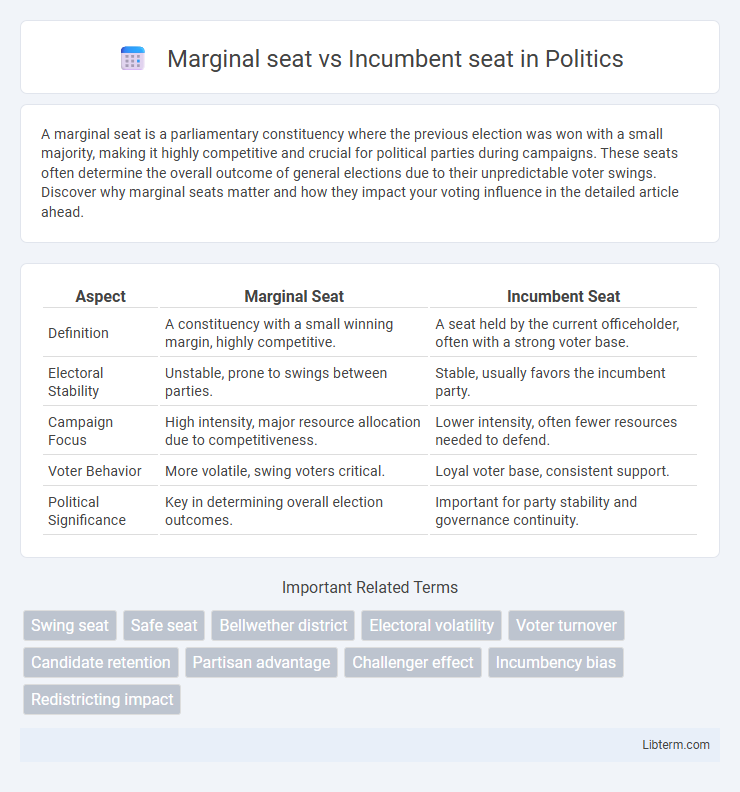A marginal seat is a parliamentary constituency where the previous election was won with a small majority, making it highly competitive and crucial for political parties during campaigns. These seats often determine the overall outcome of general elections due to their unpredictable voter swings. Discover why marginal seats matter and how they impact your voting influence in the detailed article ahead.
Table of Comparison
| Aspect | Marginal Seat | Incumbent Seat |
|---|---|---|
| Definition | A constituency with a small winning margin, highly competitive. | A seat held by the current officeholder, often with a strong voter base. |
| Electoral Stability | Unstable, prone to swings between parties. | Stable, usually favors the incumbent party. |
| Campaign Focus | High intensity, major resource allocation due to competitiveness. | Lower intensity, often fewer resources needed to defend. |
| Voter Behavior | More volatile, swing voters critical. | Loyal voter base, consistent support. |
| Political Significance | Key in determining overall election outcomes. | Important for party stability and governance continuity. |
Understanding Marginal Seats: Definition and Significance
Marginal seats are electoral districts where the winning candidate's majority is small, often less than 5%, making them highly competitive and pivotal in determining overall election outcomes. These seats attract intense campaign attention and resources from political parties aiming to swing the vote in their favor. Understanding marginal seats is crucial for analyzing election strategies and predicting shifts in parliamentary power.
What Is an Incumbent Seat? Core Characteristics
An incumbent seat refers to an electoral district currently held by a sitting officeholder who seeks reelection. Core characteristics include the advantages of name recognition, established voter base, and access to greater campaign resources, which often lead to higher reelection rates. This contrasts with marginal seats, where the incumbent's hold is uncertain, and electoral competition is significantly stronger.
Electoral Importance: Marginal vs Incumbent Seats
Marginal seats are critical battlegrounds in elections due to their narrow winning margins, making them key targets for political parties aiming to shift legislative power. Incumbent seats, held by current officeholders, often provide advantages such as name recognition and established voter bases, but can become vulnerable if voter sentiment shifts. Understanding the electoral importance of marginal versus incumbent seats helps parties allocate resources strategically to maximize election outcomes.
Historical Trends in Marginal Seat Outcomes
Historical trends in marginal seat outcomes reveal a higher vulnerability to party shifts compared to incumbent seats, which tend to exhibit greater electoral stability due to established voter loyalty and name recognition. Marginal seats frequently act as battlegrounds during elections, with fluctuating vote margins reflecting national political swings, policy impacts, and campaign effectiveness. Data from past election cycles demonstrate that marginal seats often determine overall election results, emphasizing their strategic importance in political party resource allocation and target campaigning.
Incumbency Advantage: Factors and Impact
Incumbency advantage refers to the electoral edge enjoyed by sitting representatives due to factors such as name recognition, established voter relationships, and access to campaign resources. Incumbent seats typically experience higher reelection rates compared to marginal seats, where competition is intense and voter allegiance is less predictable. This advantage impacts electoral stability by reinforcing the status quo and reducing the likelihood of turnover in legislative bodies.
Campaign Strategies for Marginal and Incumbent Seats
Campaign strategies for marginal seats often prioritize targeted voter outreach, persuasive messaging, and mobilizing undecided voters to sway tight electoral outcomes. Incumbent seat campaigns focus on leveraging name recognition, showcasing legislative achievements, and reinforcing constituent relationships to maintain established support bases. Both strategies utilize data analytics to optimize resource allocation but differ in emphasis based on the seat's competitive landscape.
Voter Behavior in Marginal Seats vs Incumbent Seats
Voter behavior in marginal seats is often characterized by heightened electoral volatility, as these constituencies exhibit close competition between candidates, prompting voters to be more attentive to policy promises and short-term gains. In incumbent seats, voter loyalty and party affiliation tend to be stronger, resulting in more predictable electoral outcomes and reduced impetus for strategic voting. The differential voter behavior impacts campaign strategies, with parties allocating more resources and targeted messaging to marginal seats to sway undecided or swing voters.
Marginal Seats in Recent Elections: Key Examples
Marginal seats, characterized by narrow victory margins, play a critical role in shaping electoral outcomes as seen in recent elections across countries like the UK, Australia, and Canada, where shifts in these constituencies have often determined the balance of power. Notable examples include the 2019 UK General Election, where marginal seats in the Midlands and North England swung in favor of the Conservative Party, highlighting their strategic importance. These marginal seats often experience intensified campaigning and resource allocation due to their potential to influence overall election results.
Policy Implications: Marginal vs Incumbent Seat Dynamics
Marginal seats often drive policy decisions as politicians prioritize targeted benefits and campaign promises to secure voter support in competitive districts. Incumbent seats, with historically stable voter bases, may see less immediate policy responsiveness but stronger focus on maintaining constituent satisfaction and long-term projects. This dynamic influences legislative agendas, with marginal seats pushing for short-term, visible outcomes while incumbents emphasize sustained governance and incremental reforms.
Future Outlook: Shifting Battlegrounds and Political Influence
Marginal seats, characterized by narrow victory margins, increasingly dictate electoral outcomes and political strategies due to their unpredictability and potential to swing power. Incumbent seats offer established political influence but face growing challenges as demographic shifts and changing voter priorities transform traditional strongholds into competitive battlegrounds. The future political landscape hinges on parties' abilities to adapt campaigns and policies to the evolving dynamics in both marginal and previously secure incumbent constituencies.
Marginal seat Infographic

 libterm.com
libterm.com